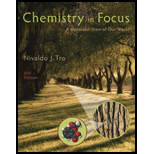
Concept explainers
Interpretation:
The reason for the disappearance of solid
Concept Introduction:
Solid, liquid and gas are the three states of the matter. Their existence depends on the prevailing intermolecular forces. If the forces are very strong, the molecule exists as a solid at room temperature.
When these forces start decreasing, the state changes from solid to liquid. This is termed as melting. On further decrease in the intermolecular forces, liquid changes to a gas. This is termed as vaporization. Some substances bypass the liquid state and directly convert from solid state to gaseous state. This process is known as sublimation.
There is a number of intermolecular forces which play a role in different molecules such as dipole-dipole, hydrogen bonding, and dispersion forces.
The compounds lacking specific functional moieties have dispersion forces acting on their molecules. These increase with an increase in the molecular mass.
Lower are the forces of attraction, more is the volatility of the substance.
Want to see the full answer?
Check out a sample textbook solution
Chapter 12 Solutions
Chemistry In Focus
- A 1.40-g sample of polyethylene, a common plastic, is dissolved in enough organic solvent to give 100.0 mL of solution. What is the average molar mass of the polymer if the measured osmotic pressure of the solution is 1.86 mm Hg at 25 C?arrow_forwardWhat are the correct units for the boiling point elevation constant for water? oC/mol oC/kg oC*kg/mol oC*mol/kg oC*molarrow_forwardDescribe the molecular basis of the property of water responsible for the presence of ice on the surface of a frozen lake.arrow_forward
- Chemistry: Matter and ChangeChemistryISBN:9780078746376Author:Dinah Zike, Laurel Dingrando, Nicholas Hainen, Cheryl WistromPublisher:Glencoe/McGraw-Hill School Pub Co

 World of Chemistry, 3rd editionChemistryISBN:9781133109655Author:Steven S. Zumdahl, Susan L. Zumdahl, Donald J. DeCostePublisher:Brooks / Cole / Cengage Learning
World of Chemistry, 3rd editionChemistryISBN:9781133109655Author:Steven S. Zumdahl, Susan L. Zumdahl, Donald J. DeCostePublisher:Brooks / Cole / Cengage Learning  EBK A SMALL SCALE APPROACH TO ORGANIC LChemistryISBN:9781305446021Author:LampmanPublisher:CENGAGE LEARNING - CONSIGNMENT
EBK A SMALL SCALE APPROACH TO ORGANIC LChemistryISBN:9781305446021Author:LampmanPublisher:CENGAGE LEARNING - CONSIGNMENT General, Organic, and Biological ChemistryChemistryISBN:9781285853918Author:H. Stephen StokerPublisher:Cengage Learning
General, Organic, and Biological ChemistryChemistryISBN:9781285853918Author:H. Stephen StokerPublisher:Cengage Learning Chemistry: An Atoms First ApproachChemistryISBN:9781305079243Author:Steven S. Zumdahl, Susan A. ZumdahlPublisher:Cengage Learning
Chemistry: An Atoms First ApproachChemistryISBN:9781305079243Author:Steven S. Zumdahl, Susan A. ZumdahlPublisher:Cengage Learning





